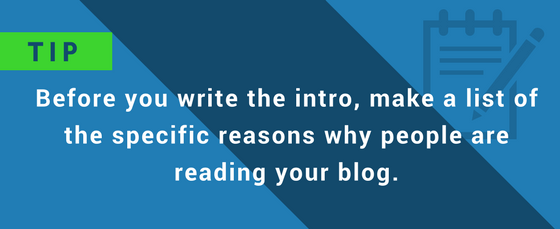How To Write More Effective Intros For Your Blog Posts
It’s no secret that writing a compelling intro is a key component of any effective blog post. But far too many writers miss the mark by adding too much unnecessary fluff and failing to hook the reader.
Whether the purpose of your blog is to inform or to convert, your intro should be equal parts captivating, practical, entertaining, and concise. After the first few sentences, your readers should know exactly how your blog will help them solve their problems and why they should continue reading.
If you’ve written dozens of blogs and shared them on social media without making conversions, or if you’ve noticed a high bounce rate from your blog posts, this article is for you. Read on to learn a few proven strategies for writing effective blog post intros:
1. Jump Right Into The Content
Writers love to flex their talents through the compelling use of schemes and tropes, but don’t lose sight of the reason why people are reading your content in the first place. Although using clever figures of speech can certainly add rhetorical value to your article, don’t make the reader wait too long before jumping into the meat of your blog.
What problem are you helping readers solve? How will your blog help them solve it? In most cases, you should answer these two questions within the first four sentences.
You can also use your title and subheadings to help the reader extract the gist of your blog at a glance. After you’ve finished writing, skim through your blog and ask yourself, “Would I know the value of this blog by just reading the title and subheadings?”
2. Hook The Reader By Appealing To The Problems That Your Blog Solves
The best intros hook the reader by making a personal connection and appealing to the problems that the content solves. For example, people who are reading this blog expect to learn how to write more effective intros—but what problem are they really trying to solve?
Maybe they’ve written dozens of articles and shared them on social media without making any conversions, or perhaps they’ve noticed a high bounce rate from their blog posts. As you may have noticed, I mentioned those two problems in the intro of this blog to tell readers that we’re on the same page, that I know why they’re reading this blog, and that they’ve come to the right place to find the solution they’re after.

3. Know Your Audience
Your audience will determine the appropriate style, diction, and structure of your blog. One key distinction to make here is whether your content needs to be formal or if you can get away with an informal style. In most cases, I’ve found that even the most formal clients have started to request an informal style to make their content more captivating.
Of course, you need to dial back your use of lit devices if you’re writing for a client who absolutely demands formality, such as certain types of attorneys. But if you’re writing a list article about the health benefits of a super food or something along those lines, feel free to flex your writing talents—but don’t go so overboard that the reader has trouble dissecting the main takeaways.
4. Use Proper Grammar

Pablo Picasso famously coined the phrase, “Learn the rules like a pro so you can break them like an artist.” Unfortunately, I see far too many writers sacrificing proper grammar where it’s unnecessary to do so.
In most cases, you can get away with ending sentences with a preposition or beginning them with a conjunction. In fact, the vast majority of grammar “rules” can and should be broken from time to time, but there are some mistakes that add absolutely no rhetorical or stylistic value to your blogs. Three common examples are:
- Using a semicolon where you should use a comma;
- Using split infinitives; and
- Using passive voice when active voice would be effective.
These tips are certainly not the only strategies for writing effective intros, but if you follow these rules, you should notice better engagement signals, a lower bounce rate, and more conversions. Feel free to share any other tips in the comment section below.
If you’d like to learn more about our blog writing services, click here or call us at 757-447-3950.





LEAVE A COMMENT